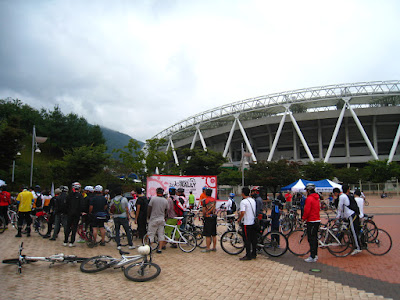And why are peanuts, which grow underground, and chestnuts, which fall off of trees inside little spiny balls, both "nuts"? We all have been told that peanuts are legumes, but what do they have in common with peas? And how are a peas different from green beans? Which part of the green bean is the bean? And, most importantly, what in God's good name is a cashew, which looks like a tree-gourd turd?
What's the difference between a sesame seed and a grain of corn and a pine nut?
Does anyone else think of Ginko as an herb? Did you know Ginko nuts fall off Ginko trees exactly like acorns from oaks? Why did I capitalize "Ginko" but not "oak"?
Carrots are vegetables, we all agree, but what about potatoes? Aren't they just starches? Ginger is doubtless a spice. Why am I uncomfortable calling 더덕 (Codonopsis lanceolata) and 도라지 (Platycodon grandiflorum) vegetables, when they need to be dug up from underground just the same as carrots?
All of this is my way of saying that I have no idea what category Lotus Root fits into. How about I shut up and show you how to turn the light, crisp unclassifiable root flesh into a sweet, oily, candied side dish?
1) Head to "Lightning Market" by the train station, buy a basket of these suckers for less than two dollars, and assure the grandma that even though you're white you know exactly what to do.
2) Rinse off all the dirt.

3) Peel and slice.

4) Boil for a bit in water with a little bit of vinegar. Drain, then fry for a minute in sesame oil. Then add soy sauce, rice syrup (the traditional Korean equivalent of honey or corn syrup), and brown sugar.

5) Sprinkle with roasted sesame seeds and serve as a side, preferably on a dish you made on 7 March 2010.

3) Peel and slice.

4) Boil for a bit in water with a little bit of vinegar. Drain, then fry for a minute in sesame oil. Then add soy sauce, rice syrup (the traditional Korean equivalent of honey or corn syrup), and brown sugar.

5) Sprinkle with roasted sesame seeds and serve as a side, preferably on a dish you made on 7 March 2010.
*Admission: Real lotus root side dishes come out with a thick, sweet gravy. Really candied. I guess I didn't throw in enough sugar and syrup. But I'd like to pretend that they came out like this because I wanted a healthier variety.
**While researching this post, I learned the rather unsurprising fact, which I assume I already knew implicitly, that, actually, all plants have roots, stems, leaves, flowers, fruits, and seeds. All nuts, cereals, seeds and beans/legumes are apparently varieties of "Seed". I suppose that things that we call "fruit" generally belong to the "Fruit" category, and that things which we call vegetables could belong to just about any category other than "Seed." Our layman's terminology is largely based on synechdoche. When we say "this is a cucumber," we mean "this is the fruit of the cucumber plant," and when we say "this is a potato," we mean "this is the root of a potato plant." And yet, we can't call a sunflower seed by the name "sunflower."
***Interestingly, in Korea, where they sometimes eat multiple parts of the same plant, one part gets priority. For instance, much as in English, the word for "sweet potato" refers to the root, and you need to add the word "stem" if you want to talk about the awesome stir-fried sweet potato stem side dish that I tried for the first time a few weeks ago. "Pumpkin" refers to the big orange or green thing, and you need to add another word to talk about pumpkin seeds or pumpkin leaves. But couldn't the word "pumpkin" just as easily refer to the leaf, in the same way that "lettuce" does, so that you'd have to buy some "pumpkin fruit" or "pumpkin gourd" if you wanted to make a pie? This may or may not raise some interesting issues in the philosophy of nomenclature. I hope they keep you up at night.
**While researching this post, I learned the rather unsurprising fact, which I assume I already knew implicitly, that, actually, all plants have roots, stems, leaves, flowers, fruits, and seeds. All nuts, cereals, seeds and beans/legumes are apparently varieties of "Seed". I suppose that things that we call "fruit" generally belong to the "Fruit" category, and that things which we call vegetables could belong to just about any category other than "Seed." Our layman's terminology is largely based on synechdoche. When we say "this is a cucumber," we mean "this is the fruit of the cucumber plant," and when we say "this is a potato," we mean "this is the root of a potato plant." And yet, we can't call a sunflower seed by the name "sunflower."
***Interestingly, in Korea, where they sometimes eat multiple parts of the same plant, one part gets priority. For instance, much as in English, the word for "sweet potato" refers to the root, and you need to add the word "stem" if you want to talk about the awesome stir-fried sweet potato stem side dish that I tried for the first time a few weeks ago. "Pumpkin" refers to the big orange or green thing, and you need to add another word to talk about pumpkin seeds or pumpkin leaves. But couldn't the word "pumpkin" just as easily refer to the leaf, in the same way that "lettuce" does, so that you'd have to buy some "pumpkin fruit" or "pumpkin gourd" if you wanted to make a pie? This may or may not raise some interesting issues in the philosophy of nomenclature. I hope they keep you up at night.











